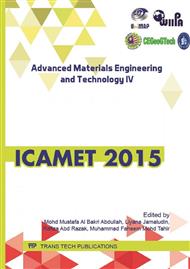p.76
p.79
p.83
p.87
p.93
p.101
p.106
p.111
p.116
Mechanical and Electrical Properties of Carbon Nanotubes Based Isotropic Conductive Adhesives
Abstract:
In the past few decades, the lead-tin soldering process had been widely used in electronics sector as an interconnection between the electronics components and printed circuit board. Due to the highly toxicity and environmental concerns, the lead-tin alloys were replaced by lead-free alloys and isotropic conductive adhesives (ICAs). The ICAs have a significant amount of conductive fillers and offers better electrical conduction seems to be more promising in the electronics sector. ICAs are usually filled with metal particles such as silver flakes with adhesive polymeric resin. For this research, the carbon nanotubes (CNTs) were used to replace silver flakes. The synthesis of CNTs was carried out by heating the mixture of ferrocene with ammonium chloride and went through purification process by hydrochloric acid. Meanwhile, the studies on CNTs were performed through several characterization methods such as scanning electron microscopy (SEM), energy dispersive X-ray spectroscopy (EDX), fourier transform infrared spectroscopy (FTIR) and Raman spectroscopy. Then, the ICAs were produced by adding different weight percent of CNTs into DGEBA. Subsequently, the ICAs went through 4 points probe test and tensile test to examine their electrical and mechanical properties. The results show that the ICAs contain 1.5wt% and 2.5wt% of the CNTs exhibit the highest electrical conductivity and highest tensile strength respectively. Undoubtedly, there was a close relation between the electrical and mechanical properties, as both of the material of CNTs and DGEBA is necessary to achieve optimum and balance of weight percentage in order to sustain both novel properties. Meanwhile, the weight percentage of the curing agent greatly depends on the amount of DGEBA. An appropriate amount of curing agent may lead to a hard shape with all other properties are preserved. In this case, the ratio of curing agent to DGEBA is 0.088:1 which is considered as the optimum ratio.
Info:
Periodical:
Pages:
93-97
Citation:
Online since:
May 2016
Authors:
Price:
Сopyright:
© 2016 Trans Tech Publications Ltd. All Rights Reserved
Share:
Citation:


